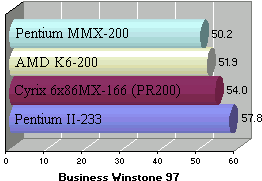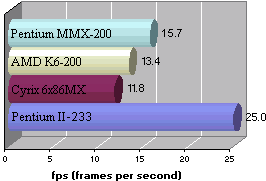Conclusion
Let's summarize every processor's
pros and cons:
Look at individual processors.
Note: Usually Cyrix processors carry the designation
IBM. IBM just manufactures them, Cyrix designs them; Cyrix is a fab-less
chip vendor.
I' Bandwidth and performance
flaw
'normal' with the flaw: (best in
red, second best
in blue).
| rates Mb/sec |
Pentium MMX-200 |
AMD K6-200 |
Cyrix 6x86MX-166 (P200) |
Pentium II-233 |
| Main memory read |
119.04 |
118.34 |
118.34 |
183.48 |
| L2 cache read |
227.27 |
240.96 |
270.27 |
425.53 |
| Main memory write |
85.47 |
69.44 |
75.75 |
68.72 |
| L2 cache write |
85.10 |
128.20 |
157.48 |
210.52 |
| Video memory write |
79.05 |
51.02 |
81.96 |
25.47 |
| Main memory transfer |
49.50 |
38.53 |
38.91 |
48.19 |
| L2 cache transfer |
70.42 |
84.03 |
95.69 |
162.60 |
| Video memory transfer |
57.63 |
36.36 |
56.33 |
25.47 |
Conclusion:
Its easily visible from the above table that bandwidth-wise
the Pentium II is the best and also that the best of the socket
7 trio is Cyrix 6x86MX. Note: On Pentium II the use of a
small utility (e.g. FASTVID) will increase significantly the video write
and transfer rates (they will exceed Pentium MMX's).
The reason why Pentium II has such improved rates is that on main memory
it supports multiple outstanding bus transactions
and that its secondary cache is on board, operating at 233/2=116.6 MHz
instead of the 66 MHz of socket 7 processors.
'innovative' without the flaw: (best
in red, second
best in blue).
(The innovative write rates on the table are achieved
using 64 bit writes, a method documented by Intel in its 1997 Optimizations
manual; the 'performance flaw' revealed in this site affects the read &
transfer rates).
| rates Mb/sec |
Pentium MMX-200 |
AMD K6-200 |
Cyrix 6x86MX-166 (PR200) |
Pentium II-233 |
| Main memory read |
200.00 |
119.76 |
200.00 |
191.64 |
| L2 cache read |
344.82 |
256.41 |
294.11 |
512.82 |
| Main memory write |
170.94 |
68.96 |
75.18 |
69.54 |
| L2 cache write |
170.94 |
116.95 |
170.94 |
210.52 |
| Video memory write |
92.59 |
92.59 |
92.59 |
51.02 |
| Main memory transfer |
95.23 |
40.24 |
43.85 |
50.28 |
| L2 cache transfer |
119.04 |
82.98 |
94.78 |
165.28 |
| Video memory transfer |
68.45 |
56.33 |
64.51 |
41.75 |
Conclusion:
With the workaround applied, it is easily visible that
bandwidth-wise Intel's processors are the best; the difficult thing is
to choose between Pentium MMX and Pentium II; with FASTVID
applied, Pentium II has the edge. (But don't forget: Pentium II
runs at 233 MHz, while Pentium MMX at 200. A 200 MHz Pentium II would be
outperformed by Pentium MMX).
The reason why AMD K6 has almost the same values as in the 'normal'
table (except video read/transfer) is that the flaw is not correctable
on K6. (Though it is correctable on the K5).
II' DOS benchmark
(best in red, second
best in blue)
| CBENCHP |
Pentium MMX-200 |
AMD K6-200 |
Cyrix 6x86MX-166 (PR200) |
Pentium II-233 |
| loop (µSecs) |
0.54 |
0.63 |
0.37 |
0.44 |
| 64k program (µSecs) |
0.58 |
0.53 |
0.45 |
0.53 |
| transfer rate (Mb/sec) |
62890 |
74350 |
79680 |
157480 |
| video write (Mb/sec) |
81300 |
51020 |
81970 |
25470 |
| Index relative to IBM PC |
291.5 |
284 |
373 |
340 |
Conclusion:
In DOS or 16 bit programs Cyrix
6x86MX PR200 is the best with second Pentium II-233.
Note: On Pentium II the use of a small utility (e.g. FASTVID) will
increase significantly the video write, to 85840, but the final index will
still be lower than Cyrix's.
III' Windows 95 benchmark

On Windows 95, Pentium II-233 is clearly the best,
with second Cyrix 6x86MX.
But its important to note, that a K6-233 reaches 55.3 and a 6x86MX
PR233 (188 MHz) reaches 56.6 !
IV' 3D/Floating Point benchmark

On Quake, Pentium II vastly outperforms all the
other processors, while second comes Pentium MMX. The reason
for that is that Pentium II has a next generation floating point unit which
is almost twice as fast. Pentium MMX outperforms the last two because AMD
and Cyrix have simpler and slow floating point units.
Final conclusion
From the above it is obvious that
the best processor in everything except 16 bit (DOS) is Pentium II; of
course Pentium II is also much more expensive and needs a special expensive
motherboard (slot 1) on which only Pentium II can operate.
For users with a recent motherboard
who wish to upgrade, the best solution is to upgrade their processor to
a Cyrix 6x86MX if they are interested in general performance or to a Pentium
MMX if they are interested mainly in 3D game or calculation performance.
The middle way, some general performance and some 3D, is AMD K6.
Cyrix 6x86MX: The good news for
budget users is that the cheapest by far processor is also very good in
general performance, as long as they can compromise on 3D/calculations.
Especially the PR233 version (188 MHz) almost catches up with Pentium II-233
on Windows 95.
Finally for professional Windows
NT/CAD/3D/calculation users there is no serious alternative than Pentium
II at the moment. The same applies to avid gamers, especially due to Pentium
II's new AGP graphic cards.
For questions, go to the Q&A
page.
For comments or suggestions, mail
us
Everything at this web site is
the property of Intelligent Firmware Ltd. You may not repost/publish this
information without our explicit permission.

